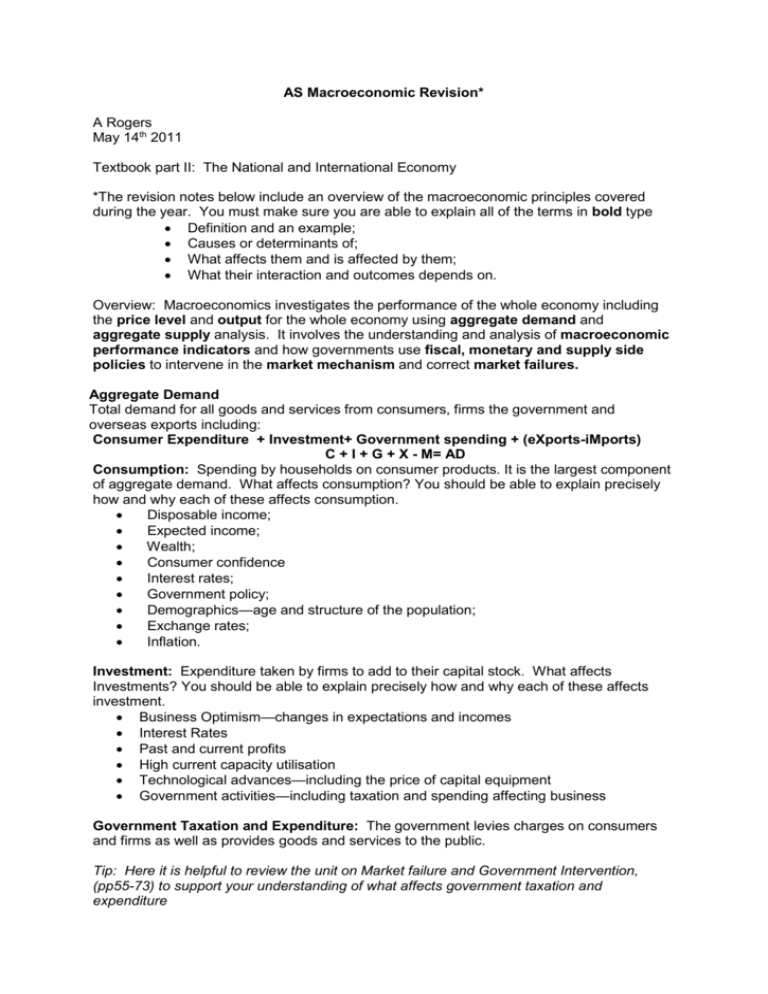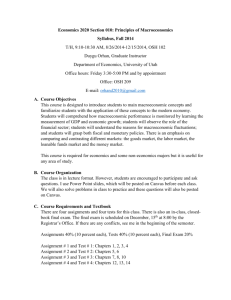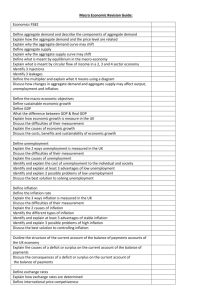AS Macroeconomic Revision* A Rogers May 14th 2011 Textbook
advertisement

AS Macroeconomic Revision* A Rogers May 14th 2011 Textbook part II: The National and International Economy *The revision notes below include an overview of the macroeconomic principles covered during the year. You must make sure you are able to explain all of the terms in bold type Definition and an example; Causes or determinants of; What affects them and is affected by them; What their interaction and outcomes depends on. Overview: Macroeconomics investigates the performance of the whole economy including the price level and output for the whole economy using aggregate demand and aggregate supply analysis. It involves the understanding and analysis of macroeconomic performance indicators and how governments use fiscal, monetary and supply side policies to intervene in the market mechanism and correct market failures. Aggregate Demand Total demand for all goods and services from consumers, firms the government and overseas exports including: Consumer Expenditure + Investment+ Government spending + (eXports-iMports) C + I + G + X - M= AD Consumption: Spending by households on consumer products. It is the largest component of aggregate demand. What affects consumption? You should be able to explain precisely how and why each of these affects consumption. Disposable income; Expected income; Wealth; Consumer confidence Interest rates; Government policy; Demographics—age and structure of the population; Exchange rates; Inflation. Investment: Expenditure taken by firms to add to their capital stock. What affects Investments? You should be able to explain precisely how and why each of these affects investment. Business Optimism—changes in expectations and incomes Interest Rates Past and current profits High current capacity utilisation Technological advances—including the price of capital equipment Government activities—including taxation and spending affecting business Government Taxation and Expenditure: The government levies charges on consumers and firms as well as provides goods and services to the public. Tip: Here it is helpful to review the unit on Market failure and Government Intervention, (pp55-73) to support your understanding of what affects government taxation and expenditure What affects Government Expenditure? You should be able to explain precisely how and why each of these affects government spending and taxation. Price Instability Unemployment--note: government spending does not include transfer payments and job seekers allowance. Balance of Payments-including supporting business competitiveness Economic growth and activity Political issues and decisions Net Exports are exports, (goods and services sold abroad), minus imports, (goods and services purchased abroad). What affects Exports and Imports? You should be able to explain precisely how and why each of these affects the balance between exports and imports. Exchange rates Inflation Interest rates Domestic and foreign incomes Government protectionist policies-you should understand and be able to explain protectionism in detail, (pp161-163). Note: make sure you remember that spending on imports reduces a country’s aggregate demand because the spending is going on foreign products, not domestically produced products. Savings: Savings is disposable income minus consumer expenditure. Savings is not a component of aggregate demand but influences the spending undertaken by households, firms, the government and foreigners. Make sure you fully revise pages 85-87. Using Diagrams The Aggregate Demand Curve Aggregate Demand Curve: The aggregate demand curve shows the relationship between the total level of demand at an overall price level. The curve slops downwards because the level of economic activity is greater at lower prices than at higher prices. As prices decrease the “real wealth” of those holding cash increases and they will spend more; When prices are low, interest rates tend to be low. This encourages both investment and consumption expenditure; A reduction in the price level increases the competitiveness of exports and reduces imports. You should be able to explain what is included in AD and what causes shifts in and movements along the AD curve. What causes movement along the aggregate demand curve? A change in change in price including a rise in the general price level causes a reduction in real output/demand; a fall in the general price level causes an increase in real output/demand. What causes shifts in the aggregate demand curve? A change in consumption attitudes towards spending and saving, (the marginal propensity to consume and save); A change in the firm’s desire to add to physical capital and inventories; A change in government demand for goods and services; A change in exchange rates increasing or reducing export demand. Key factors affecting changes in output, employment and inflation: the size of the initial change, the size of the multiplier, the original level of economic activity. Aggregate Supply: The total amount of goods and services that firms wish to supply to an economy at a given price level in a given time period. The inputs include the factors of production: Land, Labour, Capital and Enterprise. You should be able to explain what is included in AS and what causes shifts in and movements along the AS curve, in the short run and in the long run. A change in AS means that the total output that producers are willing and able to supply at any given price level has changed. Short run changes are largely du to changes in the cost of production. Long term shifts supply are those which alter their productive capacity and are due to changes in the quality and quantity of resources such as: ◦ Immigration Increasing the quantity of labour ◦ Investment in additional capital goods, or the replacement of capital goods with improved technology; ◦ Improvements in education and training; ◦ Reduction in rules and regulations improving business productivity; ◦ Schemes which improve infrastructure and influence the ability of workers to relocate. Key factors affecting changes in AS: the size of the change and the initial level of economic activity. You should be able to define and explain the significance of the following: Macroeconomic equilibrium The circular flow Factor services The multiplier effect Sustainable Economic Growth Trend Growth The Output Gap Macroeconomic Policy Objectives: Methods of monitoring and evaluating the performance of the economy on a macroeconomic level to determine whether an intervention is necessary. You should be able to explain all of the causes and consequences of the policy objectives, why they are important, how they are measured and why they are difficult to measure. Economic growth: when an economy increases its output. ◦ Stable economic growth is growth which can continue over time ◦ Economic growth usually decreased unemployment. ◦ Governments focus on economic stability, where economies avoid significant fluctuations around the trend rate of growth. You must be able to explain how economic growth is measured and the difference between GDP and Real GDP and its significance as an indicator of standards of living. You should be able to explain labour productivity Price Stability: the control of inflation. ◦ Inflation is a sustained rise in the price level measured as a % change in the CPI. ◦ High inflation imposes costs on society and reduces the effectiveness with which markets work. ◦ The price level can increase as the result of either increases in AD or AS; cost push or demand pull. ◦ Sustained inflation can only take place if there is also a sustained increase in the money supply, seen as persistent shifts in the demand curve. Full Employment: when those wanting and able to work can find employment at the going wage rate. ◦ Frictional unemployment is while people are in between jobs; ◦ Structural unemployment occurs when there is a mismatch between workers skills and the skills needed. ◦ Demand deficient unemployment occurs as a result of the economy being below the level of full employment; ◦ Involuntary unemployment is when workers would like to accept a job at the going rate but are unable to find employment. ◦ Unemployment benefits may encourage some workers not to accept jobs as the opportunity cost of working is high. Balance of payments: The balance of payments is a set of accounts that contains the detail of the transactions that take place between the residents of one economy and the rest of the world. ◦ Balance of payments must always equal 0. A current account deficit must be balanced by a surplus on the finance account. A surplus on the finance account is generally the receipt of loans to finance the current account deficit. ◦ A deficit on the current account means that, countries are spending more than they are earning. ◦ Current account deficits can only be maintained as long as their future earning potential is good. ◦ The quantity of exports of goods and services from the UK depends partly on income levels in the rest of the world and partly on the competitiveness of UK goods and services. ◦ The competitiveness of UK goods and services depends partly on the exchange rate and partly on relative price levels. Policy Conflicts Growth and Inflation ◦ Rising AD may lead to rising prices and an increase in spending on imports. ◦ If the economy is close to its full capacity, economic growth will be a cause of higher rates of inflation if growth is generated by increases in AD that are not matched by increases in AS. ◦ As the output gap narrows, inflationary pressure can build up. ◦ It is possible to avoid inflation by increasing the economy’s productive capacity Economic Growth and Unemployment ◦ Increasing labour productivity may reduce employment in the short run, if firms choose to produce the same output but with fewer workers. Economic Growth and the Balance of Payments ◦ Rising consumption is likely to increase the demand for imports. ◦ Imports of capital goods will increase the productive potential of an economy, resulting in a greater ability of firms to meet domestic demand Managing Policy Objectives: Macroeconomic policies are used to help stabilise the economy by influencing shifts in aggregate supply and demand. Demand Side Policies: Short to medium term policies that affect both firm’s and consumer expenditure and confidence in the future of the economy. Fiscal Policy—Using government expenditure and taxation to influence the path of the economy; Problems with Fiscal policy: 1. Difficulty in knowing when and by how much to expand public spending or cuts taxes. 2. Crowding out: The government raises tax rates to finance public sector spending but results in the private sector having less to spend itself. 3. Contractionary policies can reduce competiveness, employment and economic growth. 4. Expansionary policies can cause inflation and unemployment. You should be able to explain types of taxes. Monetary Policy—those used by the Bank of England to affect the money supply and interest rates. Supply Side Policies: Medium to long term policies aimed at improving the production potential of the economy and to encourage investment. Supply side policies are aimed at: ◦ Labour market improvements: Education and training; Measures to reduce voluntary unemployment; Labour market reforms including reducing trade union power; Incentives to get people to work harder, such as reducing the marginal tax rate. ◦ Improving Competition Removing restrictions/barriers to trade. Removing monopolies, predatory pricing, price fixing etc. Privatisation ◦ reduction of subsidies to inefficient producers ◦ Increasing Enterprise and Productivity: o Policies aimed to improve both incentives and the prospects for entrepreneurs and small businesses o Reducing VAT thresholds, o Reducing administration for small businesses; o Reducing corporation tax; o Funding/encouraging research and development. o Privatization o NMW You should be able to explain the significance and the effectiveness of the above to the economy and be able to describe the following: The determination of exchange rates The relationship between exchange rates and interest rates as well as import and export prices. The areas of the world with which the UK trades Advantages gained from trade Methods of protectionism Exam Skills: Preparing and structuring your essays. For longer mark questions you should always plan your answers before starting to write. Example: Q: Discuss the effectiveness of monetary policy in reducing inflation. 1. Identify the meaning of the command word in the question to ensure that your answer fully, (in this case: discuss, which means to show both sides of the argument and a judgement on which side is stronger) 2. Underline the variables in the question. Most questions include at least two variables such as: discuss the effectiveness of monetary policy in reducing inflation. 3. Identify the key concepts that need defining, in this case: monetary policy and inflation. Consider not only the policies that are used to reduce inflation but also their effectiveness 4. Note the concepts that you intend to analyse, for example, what impacts on the effectiveness of monetary policy. 5. Make a judgement regarding the effectiveness of monetary policy based on the evidence you have provided, (what its effectiveness depends on).







